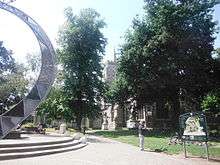Watford
| Watford Borough of Watford | ||
|---|---|---|
| Town & Borough | ||
|
Watford skyline | ||
| ||
| Motto: Audentior[1] | ||
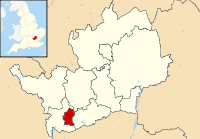 Watford within Hertfordshire | ||
| Coordinates: 51°39′18″N 0°23′44.5″W / 51.65500°N 0.395694°WCoordinates: 51°39′18″N 0°23′44.5″W / 51.65500°N 0.395694°W | ||
| Country | United Kingdom | |
| Constituent country | England | |
| Region | East of England | |
| County | Hertfordshire | |
| Borough | Watford | |
| UK Parliament constituency | Watford | |
| Government | ||
| • Type | Elected Mayor & Cabinet | |
| • Mayor | Dorothy Thornhill (Liberal Democrat) | |
| • MP | Richard Harrington (Conservative) | |
| Area | ||
| • Borough | 8.3 sq mi (21 km2) | |
| Elevation | 233 ft (71 m) | |
| Population | ||
| • Borough | 90,301[2] | |
| • Ethnicity |
77.8% White British 7.7% Other White 11% South Asian 3.5% Black African[3] | |
| Time zone | GMT | |
| • Summer (DST) | Summer Time (British) (UTC+1) | |
| Postcode area | WD | |
| Area code(s) | 01923 & 020 | |
| Website | www.watford.gov.uk | |
Watford (![]() i/ˈwɒtfərd/) is a town and borough in Hertfordshire, England, situated 17 miles (27 km) northwest of central London and inside the circumference of the M25 motorway. It is not to be confused with Watford, Northamptonshire which is 55 miles to the north.
i/ˈwɒtfərd/) is a town and borough in Hertfordshire, England, situated 17 miles (27 km) northwest of central London and inside the circumference of the M25 motorway. It is not to be confused with Watford, Northamptonshire which is 55 miles to the north.
The town developed along a road running uphill from a ford of the River Colne. The land belonged to St Albans Abbey until the 16th century. In the 12th century the Abbey was granted a charter allowing it to hold a market here, and the building of St Mary's Church began. The town grew modestly, assisted by travellers passing through to Berkhamsted Castle and the royal palace at Kings Langley. A big house was built at Cassiobury in the 16th century. This was partly rebuilt in the 17th century and another substantial house was built nearby at The Grove. Connections with the Grand Junction Canal (from 1798) and the London and Birmingham Railway (from 1837) allowed the town to grow more rapidly, with paper-making mills, such as John Dickinson and Co. at Croxley, influencing the development of printing in the town which continues today. Two industrial-scale brewers Benskins and Sedgwicks flourished in the town until their closure in the late 20th century. Today Watford is a major regional centre for the northern home counties. Hertfordshire County Council designates Watford, along with Stevenage, to be its major sub-regional centre. Several head offices of national companies and multi-nationals are based in Watford. Both the 2006 World Golf Championship and the 2013 Bilderberg Conference took place at The Grove hotel.[4]
Watford was created as an urban district under the Local Government Act 1894, and became a municipal borough by grant of a charter in 1922. The borough had 90,301 inhabitants at the time of the 2011 census. The borough is separated from Greater London to the south by the urbanised parish of Watford Rural in the Three Rivers District. The Watford subdivision of the Greater London Urban Area, which includes much of the neighbouring districts, had a total population of 120,960 in the 2001 census. Watford Borough Council is the local authority, with a directly elected mayor as head. The Mayor of Watford is one of only 18 directly elected mayors in England; Dorothy Thornhill has been the mayor since the directly elected system was set up in May 2002, and is both the first Liberal Democrat and first female directly elected mayor in the United Kingdom. Watford elects one Member of Parliament (MP) for the Watford constituency. Prior to the establishment of this constituency in 1885 the area was part of the three-seat constituency of Hertfordshire.
History
Origins
There is evidence of some limited prehistoric occupation around the Watford area, with a few Celtic and Roman finds, though there is no evidence of a settlement until much later.[5] Watford stands on a low hill near the point at which the River Colne was forded by travellers along an ancient trackway from the south east (the London area) to the north west (the Midlands) – heading for the Gade valley and thence up the Bulbourne valley to a low and easily traversed section of the Chiltern Hills near Tring. Watford's High Street follows the line of this route on the northern side of the ford.[6][7] The town was located on the first dry ground above the marshy edges of the River Colne. The name Watford may have arisen from the Old English for "waet" (full of water – the area was marshy), or "wath" (hunting), and ford.[5] St Albans Abbey claimed rights to the manor of Cashio (then called "Albanestou"), which included Watford, dating from a grant by King Offa in AD 793.[8]
Early history

The name Watford is first mentioned in an Anglo-Saxon charter of 1007, where "Watforda" is one of the places marking the boundary of "Oxanhaege"; this is believed to refer to the ford . It is not mentioned in the Domesday Book of 1086, when this area was part of St Albans' Abbey's manor of cashio. In the 12th century the Abbey was granted a charter allowing it to hold a market here and the building of St Mary's Church began. The settlement's location helped it to grow, since as well as trade along this north-south through route it possessed good communications into the vale of St Albans to the east and into the Chiltern Hills along the valley of the River Chess to the west. The town grew modestly, assisted by travellers passing through to Berkhamsted Castle and the royal palace at Kings Langley. A big house was built at Cassiobury in the 16th century. This was partly rebuilt in the 17th century and another substantial house was built nearby at The Grove. The houses were expanded and developed throughout the following centuries. Cassiobury became the family seat of the Earls of Essex, and The Grove the seat of the Earls of Clarendon.[5][9]
The Sparrows Herne turnpike was established in 1762 to improve the route across the Chilterns, with the road maintained from charges levied at toll houses along the way. The location of a toll house can be seen at the bottom of Chalk Hill on the Watford side of Bushey Arches close to the Wickes hardware store; set in an old flint stone wall is a Sparrows Herne Trust plaque.[10]
In 1778, Daniel Defoe described Watford as a "Genteel market town, very long, having but one street".[11]
Industrial Revolution
_p073_-_Viaduct_over_the_River_Colne_near_Watford.jpg)

Watford remained an agricultural community with some cottage industry for many centuries. The Industrial Revolution brought the Grand Junction Canal (now Grand Union Canal) from 1798 and the London and Birmingham Railway from 1837, both located here for the same reasons the road had followed centuries before, seeking an easy gradient over the Chiltern Hills. The land-owning interests permitted the canal to follow closely by the river Gade, but the prospect of smoke-emitting steam trains drove them to ensure the railway gave a wide berth to the Cassiobury and Grove estates. Consequently, although the road and canal follow the easier valley route, the railway company was forced to build an expensive tunnel under Leavesden to the north of the town.
Watford's original railway station opened in 1837 on the west side of St Albans Road, a small, single-storey red-brick building. It closed in 1858 when it was replaced by a new, larger station at Watford Junction approximately 200 metres (220 yd) further south-east. The old station house still stands today; it is a Grade-II-listed building and is now occupied by a second-hand car dealership.[12][13] Watford Junction railway station is situated to the north of the town centre.[14]
These developments gave the town excellent communications and stimulated its industrial growth during the 19th and 20th centuries. The Grand Union Canal, allowed coal to be brought into the district and paved the way for industrial development. The Watford Gas and Coke Company was formed in 1834 and gas works built. The canal allowed paper-making mills to be sited at Croxley. The John Dickinson and Co. mill beside the canal manufactured the Croxley brand of fine quality paper. There had been brewing in Watford from the 17th century and, by the 19th century, two industrial scale brewers Benskins and Sedgwicks were located in the town.[15] The parish church of St Mary's was extensively restored in 1871.[16] The town expanded slightly during this time. In 1851 a new street off the High Street was opened, King Street, followed by Queens Road and Clarendon Road in the early 1860s. During this time, Watford had a population of around 6,500[11] The railways also continued to expand from Watford during this period; the Watford and Rickmansworth Railway opened in 1862 as a short branch line via Watford High Street to Rickmansworth (Church Street), and another branch was added to Croxley Green in 1912. The original plan was to extend the Rickmansworth line south connecting Watford to Uxbridge; this scheme failed and both the Rickmansworth and Croxley branches eventually closed.[17]
By 1891 the population of the town had risen to 17,063 and it had become very cramped. Local landowners sold land for the development of the town and it was bought up by commercial interests. Various factories and other works sprung up in Watford, mostly breweries and prints, but also engineering works, a steam laundry, a cold storage company and a cocoa processing plant. The town expanded rapidly, most of the new inhabitants moving in from London[11]
20th century
_-_geograph.org.uk_-_1506771.jpg)
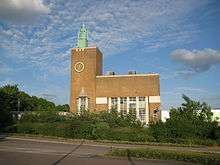
At the start of the 20th century the town was growing fast. New roads were laid out in Callowland (North Watford) and in West Watford, on what had been until then farmland. However, a lot of people still lived in the older camped and unsanitary houses in the yards and alley-ways opening off the High Street. Some of these people were among those who rioted in 1902 when celebrations for the King's coronation were postponed. The Council had a programme of slum clearance and was building council houses when the outbreak of war in 1914 brought this to a halt. This work resumed after the war and in the 1920s the Harebreaks estate was developed.[18][19]
By the 1920s, printing had become the biggest industry in Watford. The biggest printers in the town were Sun Printers Ltd and Odhams Press. Watford was the biggest printing centre in the world and many advances in printing were made in Watford. During World War II the prints were taken over by the government who used them to print propaganda.
In 1925, the Metropolitan Railway Company built a branch to Watford, opening a station close to Cassiobury Park. The company had long held an ambition to extend this route into the town centre and unveiled proposals to drive a tunnel under the park to the High Street. In 1927 it purchased the Empress Tea Rooms at 44 High Street with the intention of converting it into a Metropolitan station. The plans were opposed by local councillors and the scheme was not realised and Watford tube station remained as the branch terminus of the London Underground.[20][21]
After the war, the printing industry began going into decline. Union activity was common in Watford and advances in technology meant much of the industry became obsolete. Odhams Press closed down in 1968 and The Sun moved out of Watford during the 1980s after market reforms allowed it to do so.[22][23]
In the 1950s and 1960s, Watford was the home of the British designer furniture manufacturer Hille. At their premises on St Albans Road, designed by the modernist architect Ernő Goldfinger,[24] the designer Robin Day conceived the polypropylene stacking chair, now recognised as a classic of modern design.[25] Although Hille left the area in 1983, the listed Goldfinger building still stands on St Albans Road.[26]
The de Havilland factory at Leavesden was responsible for the manufacture of the Mosquito fighter bomber and the Halifax bomber and later became Leavesden Aerodrome, to the north of Watford. No longer operational, it was converted into Leavesden Film Studios, now famously the home of the Harry Potter films.
Geography
Watford lies on the edge of the Chiltern Hills 14 miles to the north west of London It is located on rising ground to the north of the River Colne and east of the River Gade, which have a confluence to the south west of the town. The 'ford' which gives it its name was where an ancient major route from London to the north west crossed the River Colne. Originally the settlement was of the street type close to this crossing place. The commercial centre of Watford has moved north over the centuries on to dryer ground and closer to the principal main line railway station of Watford Junction. Nineteenth century railway building made it part of the London commuter belt. Twentieth century road building has placed it close to the junction of the M1 and M25 motorways giving it a central location in the UK motorway network.
 |
Chesham | Hemel Hempstead | St Albans |  |
| Rickmansworth | |
Borehamwood | ||
| ||||
| | ||||
| Northwood | Harrow | Bushey |
Governance
Watford was created as an urban district under the Local Government Act 1894, and became a municipal borough by grant of a charter in 1922. The borough had 90,301 inhabitants at the time of the 2011 census.[2] The borough is separated from Greater London to the south by the urbanised parish of Watford Rural in the Three Rivers District. The Watford subdivision of the Greater London Urban Area, which includes much of the neighbouring districts, had a total population of 120,960 in the 2001 census.[27]
Watford Borough Council is the local authority, with a directly elected mayor as head. The Mayor of Watford is one of only 18 directly elected mayors in England; Dorothy Thornhill has been the major since the directly elected system was set up in May 2002, and is both the first Liberal Democrat and first female directly elected mayor in the United Kingdom.[28][29]
Since 1999 Watford has been divided into 12 wards.[30] Each ward has three councillors who are elected for a four-year term. Following the 2012 election the political make-up of the council is: Liberal Democrat 24 seats (including the elected mayor), Labour 8 seats, Green 3 seats, Conservatives 1 seat, Independent 1 seat.[31] The council have made twinning links with five towns. The first was Mainz, Germany, in 1956, and the most recent is Pesaro, Italy, in 1988; the others are Nanterre,[32] Novgorod, and Wilmington, Delaware.[33]
Watford elects one Member of Parliament (MP) by the first past the post system of election, for the Watford constituency. Prior to the establishment of this constituency in 1885 the area was part of the three seat constituency of Hertfordshire.
Economy
Watford is a major regional centre for the northern home counties. It is the most westerly of these commercial centres and the only one in Hertfordshire. Hertfordshire County Council designates Watford and Stevenage to be its major sub-regional centres, heading its list of preferred sites for retail development.[34] The High Street is the main focus of activity at night having a high concentration of the town's bars, clubs and restaurants. The primary shopping area is the Harlequin Shopping Centre, a large purpose-built indoor mall with over 140 shops, restaurants and cafes built during the 1990s, opened officially in June 1992. The owners of the shopping centre, Capital Shopping Centres, rebranded all their shopping centres, resulting in The Harlequin changing name to intu Watford Shopping Centre from May 2013.[35]
The town contains the head offices of a number of national companies such as J D Wetherspoon, Camelot Group, Mothercare, Bathstore, and Caversham Finance (BrightHouse). Watford is also the UK base of various multi-nationals including Hilton Worldwide, Total Oil, TK Maxx, Costco, JJ Kavanagh and Sons, Vinci and Beko.
Both the 2006 World Golf Championship and the 2013 Bilderberg Conference, took place at The Grove hotel.[4]
The town was home to the Scammell Lorries Factory from 1922 until its closure in 1988. The site is now a residential area. Tandon Motorcycles, founded by Devdutt Tandon, were also manufactured in Colne Way, By-Pass road, Watford from 1947 until 1959. Models included the Imp, the Milemaster, the Superglide and the Kangaroo.
Plans are underway to develop a new health campus adjacent to the site of the current Watford General Hospital.
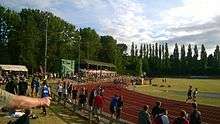
Parks
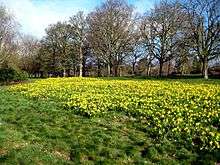
There are 43 public parks, gardens, recreation grounds and allotments in Watford. Of these, 8 have been awarded a Green Flag, in recognition of their quality.
Cassiobury Park
The name Cassiobury has had various spellings over time. It is derived from 'Caegshoe', which is believed to be the combination of 'caeg', a persons name, and 'hoe', meaning a spur of land. When the land was granted to Sir Richard Morrison in the 16th century, it was called 'Cayshobury', with 'bury' indicating a manor.[5][9]
Cassiobury Park was formed from the grounds of Cassiobury House and consists of 190 acres (0.77 km2) of open space. The house itself was demolished in 1927 and the original imposing gatehouse entrance – the Cassiobury Gates – in 1970, due to road widening. In July 2007, the park won a Green Flag Award, which recognises the best green spaces in the country.[36] There is a children's play area, which includes a paddling pool, play equipment, a bouncy castle, an ice cream van, a kiosk where one may buy food, and 10.25" gauge miniature railway. The Grand Union Canal passes through the park.
Cheslyn House and Gardens
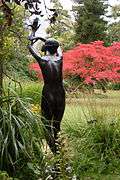
Awarded Green Flag status since 2009, Cheslyn has been open to the public since 1965 as a formal gardens and house. The 3.5 acre gardens comprise a formal open area to the front and a semi-natural woodland area to the rear. Henry and Daisy Colbeck originally owned the house and gardens. Mr Colbeck was a renowned local architect, and designed Cheslyn House; he and his wife created the original gardens. The Colbecks travelled extensively, and this is reflected in the range of unusual and exotic plants in the gardens. Since the space has been open to the public it has been further developed, with new features added such as the pond, rock garden, large herbaceous borders and aviary.
Woodside Park
Awarded Green Flag status since 2011, Woodside Playing Fields cover approximately 59 acres of playing fields, sports facilities and woodland. The site comprises a range of sports facilities including an eight lane synthetic track and stadium, an indoor bowls green, cricket squares, football pitches and Woodside Leisure Centre. Woodside Stadium is home to Watford Harriers Athletics Club and hosts national level events such as the British Milers Club Grand Prix. The wider parkland includes two children's play areas and Albans Wood is a local nature reserve.
Theatres
Watford Colosseum

Watford Colosseum was built in 1938 as the Watford Town Hall Assembly Rooms to the design of architect Charles Cowles-Voysey and acoustician Hope Bagenal.[37] It acquired a worldwide reputation for its fine acoustics,[38] and throughout the second half of the twentieth century the hall was used for concerts and recordings by leading orchestras and musicians.[39] Rising costs and falling attendance led the council to close the hall in 1994, reopening it in 1995 as the Colosseum in a joint management agreement with a commercial company who had previously operated at the Town and Country Club in London.[38][39] After the management company collapsed in 2004, the hall was managed by Watford Council until April 2010, when it closed to undergo a £5.5 million refurbishment; reopening in August 2011 with new management.[40]
Concert life at the hall collapsed with the management change in 1994 but was revived two years later by the Classic Concerts Trust. The trust presented regular concerts by the English Classical Players until the end of 2009.[38] The Watford Colosseum was used to record various film soundtracks, including The Lord of the Rings, The Sound of Music, and Sleepy Hollow; and among classical recordings, Julian Lloyd Webber's performance of Elgar's Cello Concerto, conducted by Yehudi Menuhin.[40] It is regularly used to host concerts by the BBC Concert Orchestra, including Friday Night is Music Night, and has housed performances by performers including The Who, Robbie Williams, and Oasis.[39] On Thursday 8 January 2015, Watford Colosseum hosted BBC Question Time.[41]
The acoustics were analysed by an acoustics company in 2009, who reported that the size and "shoebox" shape of the hall, the flat floor, and the materials used in construction, allow for pleasant reverberation and good sound quality and clarity, such to make the hall among the best in Europe.[37]
Watford Palace Theatre
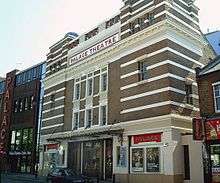
The Watford Palace Theatre is the only producing theatre in Hertfordshire. It presents world premières, dance, family shows and an annual traditional pantomime. Situated just off the High Street, the Edwardian building was opened in 1908 and the 600-seat theatre underwent a refurbishment in 2004. It houses its own rehearsal room, wardrobe, cafe, and bar. The Palace also shows films and 'live' and 'as live' streams of opera and ballet during its theatre season.
The Pump House
The Pump House Theatre and Arts Centre is based in an old pumping station situated just off the Lower High Street. The building was converted for use as a theatre, with rehearsal rooms, and meeting place for local arts based groups. Current facilities include a 124-seat theatre, rehearsal rooms, and live music venue. Community groups currently meeting at the Pump House include Dance House (children's ballet), Pump House Clog Morris (women's Morris dancing), Pump House Jazz (jazz club), Open House (live open mic music), Woodside Morris Men (men's Morris dancing), child, youth and adult theatre groups and also the Giggle Inn comedy club.[42]
Museums
Watford Museum
Watford Museum, housed in a former brewery building on the Lower High Street, is home to a collection of fine art and sculpture which includes works by J. M. W. Turner, Sir Joshua Reynolds, William Blake and Jacob Epstein. The museum also hold special collections related to the Cassiobury Estate, Watford Football Club, and local heritage, as well as an archive collection of documents, printed ephemera, photographs and diaries related to Watford townsfolk, local government, nobility and businesses.[43]
Leavesden Film Studios
.jpg)
Warner Bros. Studios, Leavesden is an 80-hectare film studio complex which has been used for a wide range of Hollywood film productions. Part of the site is open to the public and houses the Making of Harry Potter Studio Tour, displaying costumes and sets from the Harry Potter films which were produced at Leavesden. The studio complex is to the north of the borough, around 4 kilometres (2.5 mi) from the town centre, and a special shuttle bus provides a connection from Watford Junction station to the studios.
Hertfordshire Fire Museum
The museum is based in a purpose built building at the Watford Fire Station, on the same street as Watford Museum. The Museum includes a wide range of vehicles, equipment, uniforms and archive material.
Heritage
There are 92 nationally listed buildings in Watford. The two top-graded buildings are St Mary's Church—which dates to the 12th century—and Holy Rood Church which was designed by the acclaimed architect John Francis Bentley.[13] There are ten conservation areas and one Grade II Listed Park and 240 locally listed buildings.[44]
Transport
Watford is close to the orbital M25 and the M1 which links London to the Midlands and the North.
Buses
Watford is served by buses which link it to the wider surrounding area. These are operated by a number of different companies, including Arriva Shires & Essex, Arriva London, Uno, Red Rose Travel, Carousel, Mullany's Buses, Redline Buses and Tiger Line. Oyster Cards are accepted on TfL routes 142 (towards Brent Cross) and 258 (towards Harrow) into London. Intalink Explorer and Hertfordshire SaverCard is accepted on all but the London Bus routes.
Rail
Central Watford is served by 3 railway stations and a Tube station. One of the principal National Rail north-south rail routes, the West Coast Main Line, passes through Watford. Trains on this line run from London Euston to the English Midlands, North-West England and Scotland, and some long-distance trains on this route serve Watford Junction. The station is mainly served by frequent suburban and regional trains operated by London Midland which run to Tring and Milton Keynes and the cross-London Southern service to Clapham Junction via Shepherd's Bush. Two all-stations services terminate at Watford Junction: the suburban metro service operated by London Overground which runs to Euston; and the London Midland shuttle train via the Abbey Line to St Albans Abbey.
The London Overground service from Watford Junction runs south via a suburban loop and stops at the closest station to Watford town centre, Watford High Street, before continuing via Bushey via the Watford DC Line to London Euston. Watford North railway station is the first stop on the northbound Abbey Line, serving the suburban area of North Watford.
In the west of the town, Watford Met is currently the terminus of the Watford branch of London Underground's Metropolitan line at the outer north-western boundary of the Tube system. The station is located outside the centre of Watford, close to Cassiobury Park.
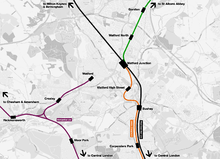
| Pic | Station | Services | Notes |
|---|---|---|---|
 | Watford Junction | |
West Coast Mainline local & regional services Abbey Line |
| | Watford High Street | | Watford DC Line & Metropolitan Line from 2018 |
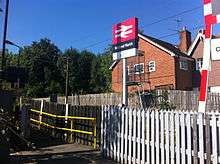 | Watford North | | Abbey Line |
| | Watford tube station | | Scheduled to close to passengers in 2018 |
| Future stations | |||
| Watford Vicarage Road tube station | | Set to open in 2018 | |
| Cassiobridge tube station | | Set to open in 2018 | |
Air
Hourly bus services connect Watford Junction station and the town centre to Heathrow Airport on weekdays, with a service once every two hours at weekends and on bank holidays. Regular bus services run between Watford and Luton, but not directly to Luton Airport. Direct train services run from Watford Junction Station to Birmingham Airport and also used to run to Gatwick (since 2009 it is necessary to change train at Clapham Junction or London Euston and London Victoria Station). Watford contains 2f flight squadron part of the air training core, 2f is the oldest running air cadet flights in the world.
Watford's closest airfield is Elstree Aerodrome, 3 miles (5 km) east of the town. Several private charter companies and flying clubs are based there.
Transport schemes

A project is under way to extend the Tube into the town centre: the Croxley Rail Link will divert the Metropolitan line branch to Watford Junction by reinstating a stretch of disused railway, the Watford and Rickmansworth Railway which used to run trains to Croxley Green until it closed in 1996. The new route, expected to open in 2020,[45][46] will provide two new Underground stations at Cassiobridge and Watford Vicarage Road and will share track with London Overground from Watford High Street to Watford Junction. As a result of the diversion of the line, Watford Met will close to passengers.[47]
On 7 August 2014 Transport Secretary Patrick McLoughlin announced proposals to extend Crossrail into the Hertfordshire area. The £6 billion proposals are, in part, designed to ease congestion on Euston station and allow its redevelopment ahead of completion of HS2 between London and the West Midlands. The proposals would connect Watford Junction and other commuter stations such as Harrow and Wealdstone, Hemel Hempstead, Berkhamsted and Tring to Crossrail and the City and Canary Wharf via Old Oak Common in West London. It would therefore not be necessary to change at Euston to get to these areas. Proposals would in theory cut travel times from Watford Junction to Liverpool Street to just 37 minutes and from Watford Junction to Canary Wharf to just 43 minutes.
A scheme to introduce light rail to Watford was conceived in 2009 when it was proposed that the Abbey Line should be converted to tram-train operation and run by Hertfordshire County Council.[48] The project was cancelled due to the complications and expense of transferring the line from National Rail to the county council.[49]
In 2008 a proposal was made that Regional Eurostar services could run via Watford to Paris via Kensington Olympia.[50] In 1999 the Select Committee on Environment, Transport and the Regions took the view that Watford was "well placed to become an integrated transport hub" and it recommended that "services from Watford to Paris should commence as soon as possible".[51] The Regional Eurostar scheme eventually came to nothing and was put on hold indefinitely.[52]
Water
Watford is on the main Grand Union Canal route northwards from London. There is little commercial use, since the advent of the motorways, but the canal is used for recreational purposes. The River Gade and the River Colne flow through Watford.
Cycling
Watford town centre and the surrounding area is relatively compact and the terrain is generally quite flat. Over 15 km of new cycle routes have been developed in the town since 2003 and a range of cycle maps are available locally. In Watford cycling to work makes up 2.2% of all journeys compared with 1.6% across the whole of Hertfordshire.[53]
National Cycle Routes 6 and 61 run across the eastern and southern sides of the town, utilising the off-road Ebury Way and Abbey Way. There is a continuous cycle route through the north-south axis of the town centre, including the pedestrianised parts along The Parade and High Street. Cycle parking is provided at intermittent points in the town centre and at local centres in the wider town.
Education

The earliest records of schooling in Watford are of a schoolmaster named George Redhead in 1595, and of a Free School receiving an annual donation of £10 in 1640. The school consisted of "a room over two houses belonging to the Church Estate, nearest the churchyard."[6] In 1704, Elizabeth Fuller of Watford Place built a new Free School for forty boys and twenty girls on her land next to the churchyard, with rooms for a master and a mistress.[14] In the mid-19th century, the recorded schools in Watford were Fuller's Free School, by now in a poor state, and the separate boys and girls national schools of St Mary's in Church Street. All offered elementary education.
State-funded elementary schools began to appear in the 1860s and 1870s. The Free School closed in 1882, and its endowment contributed to founding the Watford Endowed Schools, which provided secondary education and charged fees.[54] After these schools, now called the Watford Grammar School for Boys and the Watford Grammar School for Girls, moved to new sites in 1907 and 1912, the building housed the Watford Central School, which taught pupils up to the age of 14. St Mary's National Schools closed in 1922, and the site is now a car park.[55][56] The London Orphan Asylum, later Reed's School, was located near Watford Junction station between 1871 and 1940. The buildings are now the Reeds housing estate off Orphanage Road.
All the state-funded primary schools in Watford are co-educational. Under an earlier system, schools were divided into infant schools, covering Reception and Years 1 and 2, and junior schools, covering Years 3 to 6. Most such schools have amalgamated to form Junior Mixed Infant schools or (equivalently) primary schools, and all new schools are of this type. Within the municipal borough, there are now 6 linked pairs of infant schools and junior schools, and 14 JMI or primary schools, of which 2 are Roman Catholic. Watford is also served by schools in the neighbouring districts of Three Rivers and Hertsmere.
Although all state-funded secondary schools in Hertfordshire are comprehensive, there is a great deal of differentiation in the southwestern corner of the county, centred on Watford but also including most of the Three Rivers district and Bushey in Hertsmere district. Within this area, there are:[57]
- partially selective schools, which offer a proportion of places according to ability or aptitude, and the rest to siblings or those living near the school: Parmiter's School, Queens' School, Rickmansworth School, St Clement Danes School, Watford Grammar School for Boys and Watford Grammar School for Girls.
- Bushey Meads School, which selects 10% for technological aptitude and uses banded admissions to ensure a comprehensive intake for the remainder.
- non-selective Roman Catholic schools, whose intake is evenly spread: St Joan of Arc Catholic School and St Michael's Catholic High School.[58]
- other non-selective schools, whose intake is markedly affected by the above partially selective schools: The Bushey Academy, Francis Combe Academy and Westfield Academy.[59]
- Falconer School, a school for boys with emotional and behavioural difficulties.
The partially selective schools and Bushey Meads School operate common admissions tests in mathematics and non-verbal reasoning each autumn. In addition to those seeking selective places, all applicants to Bushey Meads and Queens' School, Bushey are required to take the tests, so they are taken by the majority of Year 6 children in the area. The partially selective schools also operate a common test and audition procedure to select children for specialist music places.[57]
Results achieved by the schools at GCSE are also widely spread, including the three highest and the two lowest scoring state schools within Hertfordshire.[60][61] The area also has by far the highest incidence in the county of children allocated to schools to which they had not applied.[62]
The only independent secondary school in the borough is Stanborough School, a day and boarding school operated by the Seventh-day Adventist Church. There several independent schools nearby, including Purcell School, a specialist music school.
The Watford Campus of West Herts College is the only grade 1 further education college in the United Kingdom according to a 2011 Ofsted report. The Centre for Missional Leadership (CML) is the Watford branch of the London School of Theology, Europe's largest evangelical theological college,[63] and teaches an applied theology course in missional leadership, accredited by Middlesex University.
Sport

Watford is home to professional football team Watford F.C., who reached the 1984 FA Cup Final, also finishing as league Division One (now the Premier League) runners-up in 1983. They were relegated from Division One in 1988. In 1996, Watford was relegated from the new Division One (now the Football League Championship). Watford won the then Nationwide Division Two championship in 1998, then the following season (1998–99) reached the Premier League. The club was relegated the next season. After five years of uncertainty, Watford won the Football League Championship Play-Off Final achieving promotion to the Premier League in 2006, this time beating Leeds United A.F.C. by three goals to nil. The club was relegated to the Football League Championship after a single season (2006–2007) in the Premier League. They were promoted to the Premier League in 2015, after finishing 2nd in the Championship. Singer-songwriter Sir Elton John is a keen, long-term supporter of Watford F.C. and a former club chairman. He still maintains his links with Watford as Honorary Life President.[64] Between 1997 and 2013 the club shared its ground, Vicarage Road, with Saracens Rugby Football Club.
Watford has a Non-League football team Sun Sports F.C. who play at The Sun Postal Sports & Social Club. Watford were home to the Watford Cheetahs American Football team who played their home games at Fullerians R.F.C. between 2008 and 2012 and Glen Rovers, who play both Hurling and Gaelic Football. The town also has a cricket team, Watford Town, and several Sunday League football clubs.
Notable people
Watford was the birthplace of:
- Bruce Alexander (1946–), actor, best known as Superintendent Norman Mullet in A Touch of Frost
- Rene Alperstein (1964), actress
- Barbara Amiel (1940–), journalist
- Stephen Andrew, Canadian television reporter, presenter and talk show host
- Michael Attwell (1943–2006), actor
- Marion Bailey (1951–), actress
- Grant Benson (1963–), broadcaster
- Michael Bentine (1922–1996), comedian and former Goon
- Anthony Berkeley Cox (1893–1971), crime fiction author
- Tom Carroll (1992–), footballer for Tottenham Hotspur
- Sue Cleaver (1963–), actress, best known as Eileen Grimshaw in Coronation Street
- Jack Collison (1988–), former West Ham United and Wales footballer, turned coach
- Ray Cooper (1942–), percussionist (performed in both Elton John's and Eric Clapton's bands)
- Chris Date (1941–), database guru, author of a textbook on the subject.[65]
- Steve Easterbrook (1967–), CEO McDonald's
- Steven Finn (1989–), Middlesex and England cricketer
- Cyril Fletcher (1913–2005), comedian
- Declan Ganley (1967–), businessman and political activist
- Philip Glenister (b. 1963), actor, Life on Mars
- Robert Glenister (b. 1960), actor
- Geri Halliwell (b. 1972), singer and former Spice Girl
- Sean Hoare (1963–2011), journalist
- Amos Howard, who championed the use of subterranean clover in Australia[66]
- Mark Ilott (b. 1970), former England cricketer
- Kenny Jackett (b. 1962), Welsh international footballer who spent his entire playing career at Watford; formerly manager of Wolverhampton Wanderers
- Vinnie Jones, footballer turned actor
- Anthony Joshua, super-heavyweight professional boxer
- Liz Kendall, Labour politician who attended Watford Grammar School for Girls
- Lewis Kinsella, footballer for Colchester United
- Nick Knight, cricketer turned commentator
- Rebecca Lacey, actress
- Kyla La Grange, singer-songwriter
- John Lawley, Commissioner in The Salvation Army
- Neil Lawson Baker, artist
- Simon Le Bon, lead singer for Duran Duran, born in Watford on 27 October 1958
- Nick Leeson, securities trader responsible for the collapse of Barings Bank in 1995
- Josh Lewsey, 2003 rugby World Cup winner with England, grew up in Watford
- Tim Lovejoy, television and radio presenter
- Craig Mackail-Smith, Luton Town and Scotland footballer
- Peter McMahon, footballer
- Anthony Meyer, actor
- David Meyer, actor
- Neil Mullarkey, actor best known for roles in Austin Powers
- Gerald Moore (1899–1987), pianist
- Mo Mowlam (1949–2005), Labour politician
- Mark Oaten, Liberal Democrat politician
- Stuart Parkin, physicist
- Arthur Peacocke (1924–2006), biochemist and Anglican theologian
- Thomas Webster Rammell (1814–1879), engineer of The Crystal Palace, is buried in Watford
- Paul Robinson, footballer for Watford, West Bromwich Albion, Bolton Wanderers, Leeds and now Birmingham
- Lawrence Sanderson (c.1542–1611) landowner and Vicar of Watford
- Terry Scott (1927–1994), TV and Carry On actor and comedian, blue plaque at 32 Tucker St 51°39′01″N 0°23′39″W / 51.650354°N 0.394242°W[67]
- Grant Shapps, Conservative MP for nearby Welwyn Hatfield
- Robert Simons (1922–2011), cricketer
- Kelly Smith, Arsenal Ladies, England and Great Britain footballer
- Gareth Southgate, former football player for Crystal Palace, Aston Villa, Middlesbrough and England, also managed Middlesbrough and now manager of England
- John Taylor, former rugby player for Wales and British & Irish Lions, turned commentator
- Paul Terry, former child actor, star of James and the Giant Peach
- Roger Tilling, voice actor, voiceover artist and broadcaster
- Simon Treves, actor and writer
- Ian Walker, former Tottenham Hotspur, Leicester City, Bolton Wanderers and England goalkeeper, turned football manager
- Bradley Walsh, actor, comedian and television presenter
- Mark Walsh, professional darts player
- Nat Wei, Baron Wei, politician
- Arthur Woodward (1906–1984), footballer who spent his entire career at Watford
- Frank Yallop (1964–), former footballer turned manager; currently coach of Chicago Fire
·Olajide Olatunji (1993-), rapper, comedian, actor and YouTube Personality
References
- ↑ Virgil. Aeneid. pp. VI, 95.
Tu ne cede malis, sed contra audentior ito. trans.: Yield thou not to adversity, but press on the more bravely.
- 1 2 2011 Census: Usual resident population and population density, local authorities in the United Kingdom, Accessed 8 January 2012.
- ↑ Watford Strategic Intelligence Assessment Summary
- 1 2 Charlie Skelton. "The week ahead: Bilderberg 2013 comes to ... the Grove hotel, Watford". the Guardian.
- 1 2 3 4 Mary Forsyth (1 December 2008). T. R. Slater, Nigel Goose (eds), ed. A County of Small Towns: The Development of Hertfordshire's Urban Landscape. Univ of Hertfordshire Press. Retrieved 29 January 2013.
- 1 2 William Page (ed.) (1908). "Watford". A History of the County of Hertford: volume 2. pp. 446–451. Retrieved 27 January 2013.
- ↑ W.R. Saunders (1931). History of Watford. Watford: Peacock.
- ↑ William Page (editor) (1908). The hundred of Cashio - Introduction | A History of the County of Hertford: volume 2 (pp. 319–322). british-history.ac.uk. Retrieved 29 January 2013.
- 1 2 William Page (ed.) (1908). "Watford: Manors". A History of the County of Hertford: volume 2. Victoria County History. pp. 451–464. Retrieved 19 May 2008.
- ↑ Sparrow Herne Trust Turnpike Marker, Lower High Street, Watford, Images of England, English Heritage National Monuments Record.
- 1 2 3 "Watford: Introduction". british-history.ac.uk.
- ↑ "The original Watford station". North Watford History Group. Archived from the original on 13 April 2015. Retrieved 13 April 2015.
- 1 2 "Nationally Listed Buildings in Watford". Watford Borough Council. p. 103. Archived from the original on 6 March 2012. Retrieved 13 April 2015.
- 1 2 William Page (ed.) (1908). "Watford: Introduction". A History of the County of Hertford: volume 2. Victoria County History. pp. 446–451. Retrieved 22 March 2008.
- ↑ "The History of Watford". Haberdashers Askes Boys School – Geography Department. 4 February 2008. Retrieved 11 August 2010.
- ↑ William Page (ed.) (1908). "Watford: Churches and Charities". A History of the County of Hertford: volume 2. Victoria County History. pp. 464–469. Retrieved 19 May 2008.
- ↑ Oppitz, Leslie (2000). "3. Lord Ebury's Line". Lost railways of the Chilterns. Newbury: Countryside Books. pp. 40–48. ISBN 9781853066436.
- ↑ "Slum housing in Watford, 1850s to 1930s". hertsmemories.org.uk.
- ↑ https://web.archive.org/web/20140407091449/http://www.watfordobserver.co.uk/nostalgia/crimelibrary/watfordriot/. Archived from the original on 7 April 2014. Retrieved 2 April 2014. Missing or empty
|title=(help) - ↑ Wolmar, Christian (2009). The Subterranean Railway How the London Underground Was Built and How it Changed the City Forever. London: Atlantic Books Ltd. ISBN 9781848872530.
- ↑ Goudie, F. W.; Stuckey, Douglas (1990). West of Watford : L.N.W.R., L.M.S., Metropolitan, L.N.E.R., Bakerloo, Watford, Croxley Green, Rickmansworth. Bracknell: Forge Books. ISBN 9780904662184.
- ↑ "The hub of the printing world". Watford Observer.
- ↑ Peter Lavin. "Why did Watford lose the print?". sunprintershistory.com.
- ↑ "History of Hille". Retrieved 13 April 2015.
- ↑ Abrahams, Charlotte (13 March 1999). "The people's chair". The Guardian. Retrieved 13 April 2015.
- ↑ "Hille House and Business Centre". North Watford History Group. Retrieved 14 April 2015.
- ↑ Census 2001, Key Statistics for urban areas in the South East, Office for National Statistics.
- ↑ Mike Wright (30 January 2012). "Mayor picks up MBE". Watford Observer. Retrieved 30 January 2013.
- ↑ Iain Dale (13 September 2008). "The 50 most influential Liberal Democrats: 41-50". The Daily Telegraph. TMG. ISSN 0307-1235. OCLC 49632006. Retrieved 30 January 2013.
- ↑ "The Borough of Watford (Electoral Changes) Order 1998". Legislation.gov.uk. The National Archives. Retrieved 22 January 2013.
- ↑ "About Your Councillors". Watford Council. Retrieved 22 January 2013.
- ↑ "British towns twinned with French towns". Archant Community Media Ltd. Retrieved 11 July 2013.
- ↑ Twinning, Watford Borough Council, accessed 12 October 2007.
- ↑ "Hertfordshire: an Economic Overview" (PDF). Hertfordshire County Council. November 2004. Retrieved 19 May 2008.
- ↑ "intu Watford". theharlequin.uk.com.
- ↑ Cassiobury Park, Green Flag Awards.
- 1 2 Scarbrough, Paul (6 March 2009). Acoustical Survey Report for the Watford Colosseum (PDF). Akustiks.
- 1 2 3 "Classic Concerts - Watford Archive". classicconcerts.org.uk. 2012. Retrieved 9 February 2013.
- 1 2 3 "Watford Colosseum Refurbishment". BBC News. BBC. 2 August 2010. Retrieved 9 February 2013.
- 1 2 "About the venue | Watford Colosseum". watfordcolosseum.co.uk. Retrieved 9 February 2013.
- ↑ "BBC One Question Time - Watch now 08/01/2015".
- ↑ "The Pump House Theatre & Arts Centre". pumphouse.info.
- ↑ "Watford Museum". Retrieved 16 November 2014.
- ↑ "Locally Listed Buildings in Watford". Watford Borough Council. 2010. p. 245. Archived from the original on 5 March 2012. Retrieved 13 April 2015.
- ↑ "Croxley Rail Link update". 17 December 2014. Archived from the original on 9 January 2015.
- ↑ "Croxley Rail Link will not be completed until 2020, documents reveal". Watford Observer.
- ↑ "Croxley Rail Link". Transport for London. Archived from the original on 25 March 2013. Retrieved 8 August 2013.
- ↑ Lewis, Alex (30 October 2009). "Tram service promised for St Albans to Watford Abbey Flyer rail link". Watford Observer. Watford: Newsquest. Retrieved 20 August 2013.
- ↑ "Abbey Line Light Rail Proposals". Hertfordshire County Council. Retrieved 20 August 2013.
- ↑ "Talks held at Parliament Regarding Regional Eurostar". www.publications.parliament.uk. Retrieved 21 September 2008.
- ↑ "Regional Eurostar services: The Government's Response to the Memorandum of Inquiry by the Select Committee on Environment, Transport and the Regions". Department for Transport. 30 January 2006. Archived from the original on 17 July 2007. Retrieved 21 September 2008.
- ↑ "Regions 'cheated' over Eurostar". BBC. 27 January 1999. Retrieved 21 September 2008.
- ↑ "Annual Monitoring Report". Retrieved 22 August 2015.
- ↑ W.R. Carter (1894). "Mrs. Fuller's Free School". Watford Endowed Schools Journal. 3.
- ↑ R.E. Slinn (1957). A History of Elementary Education in Watford 1704–1903. University of London Institute of Education.
- ↑ J.B. and L.V. Nunn (2003). The Book of Watford: A portrait of our town (2nd ed.).
- 1 2 Moving On – Applying for a Secondary or Upper School place, Hertfordshire County Council, 2007.
- ↑ Ofsted reports for these schools describe their intake.
- ↑ Ofsted reports for these schools discuss the effect on their intake.
- ↑ Hertfordshire: GCSE (and equivalent) results, Secondary School achievement and attainment tables 2007, Department for Children, Schools and Families.
- ↑ "Secondary schools in Hertfordshire: GCSE-level". BBC News. 10 January 2008. Retrieved 3 June 2008.
- ↑ Admissions Update 2007, Agenda Item No. 4, Hertfordshire County Council Admissions Forum, 14 June 2007.
- ↑ Journal LST Insight Autumn 2009, p. 2.
- ↑ They Shaped the Club", Watford F.C. History, 3 February 2008.
- ↑ Oral history interview with C.J. Date by Thomas Haigh on the Computer History Museum website
- ↑ Gilbert, L.A. (1983). "Howard, Amos William (1848–1930)". Australian Dictionary of Biography. Australian National University.
- ↑ Roll of Honour, The Heritage Foundation.
- "Great Scott!". Chortle. 9 May 2003.
External links
- Watford Borough Council
- Watford Observer Newspaper
- Watford Colosseum
- Watford Palace Theatre
- Watford Museum
- Watford, Hertfordshire, A Vision of Britain Through Time, Department of Geography, University of Portsmouth.
- Watford Genealogy on A Guide to Old Hertfordshire
- The Pump House Theatre and Arts Centre
- Famous Watfordians
